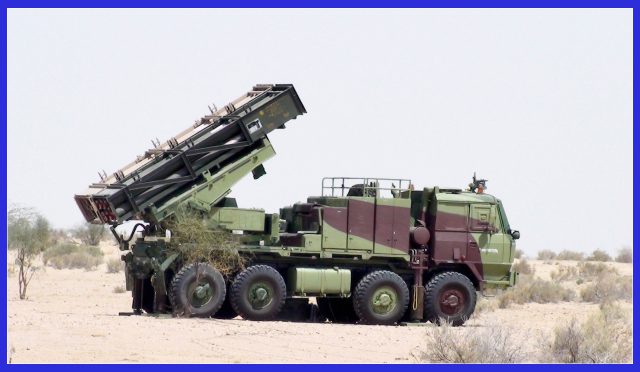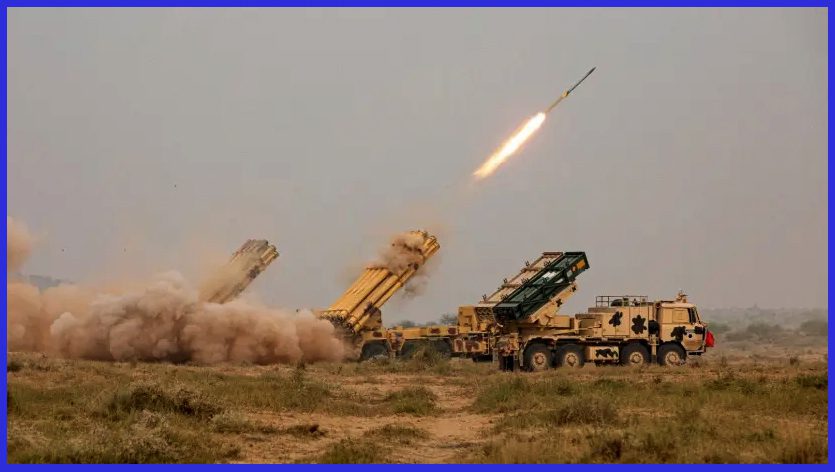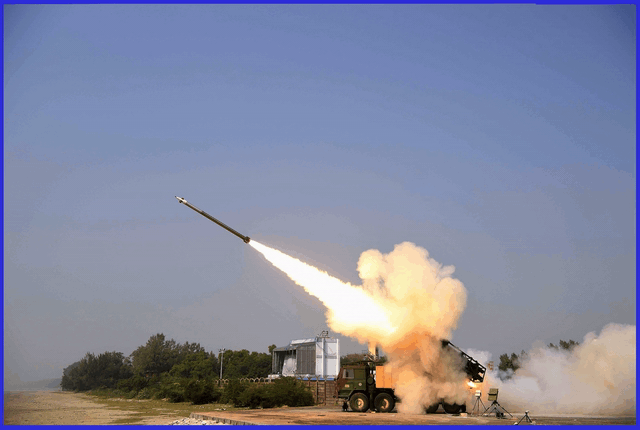A sophisticated artillery system developed by India’s Defence Research and Development Organization (DRDO) for the Indian Army is known as the Pinaka. Discover the Best of the Pinaka MBRL System, which is designed to deliver a massive payload of high-explosive rockets to a target area, making it highly effective for offensive and defensive operations.
The Pinaka system comprises a series of launch vehicles featuring multiple rocket launch tubes mounted on a shared platform. These launchers can fire a range of 214mm calibre rockets spanning distances from 40 km to 90 km. Additionally, newer variants are in development, aiming to extend the range further, potentially up to 200 km, as of 2024.

These rockets can be outfitted with various warheads, including high-explosive fragmentation, anti-tank, and incendiary options, providing adaptability in engaging different types of targets. Notably, the Pinaka system demonstrated its effectiveness (as a test) during the Kargil War, where it played a vital role in neutralizing Pakistani positions situated on mountaintops. Subsequently, it has been widely integrated into the Indian Army’s arsenal.
Pinaka MBRL (Multi-Barrel Rocket Launcher) systems are characterized by their high mobility, facilitating swift deployment and effective manoeuvrability on the battlefield. These systems are mounted on Tatra trucks to enhance mobility. They are frequently incorporated into larger artillery formations to offer long-range fire support, capable of delivering a salvo of 12 high-explosive rockets within 44 seconds to support ground forces. Renowned for their reliability, accuracy, and firepower, Pinaka MBRL systems represent a significant asset for the Indian armed forces.

As of 2014, approximately 5,000 missiles are manufactured annually, alongside ongoing development efforts focused on an advanced variant aimed at achieving extended range and enhanced accuracy. Furthermore, the Pinaka system has undergone continuous refinement and modernization, resulting in improvements in range and accuracy, as well as the introduction of guided rocket variants, thereby bolstering its combat effectiveness.
Its efficacy has been validated through participation in numerous military exercises and operations, consolidating its role as a crucial component of India’s artillery inventory. In 2019, a test-firing was conducted for an upgraded guided missile version of the system, boasting a range exceeding 90 km. The Pinaka MBRL is recognized for its cost-effectiveness in comparison to other systems. With a price of ₹2.3 crore (US$290,000) per system, it represents a significantly more affordable option than the American M270, which commands a price tag of ₹19.5 crore (US$2.4 million).

Modes of Operation of Pinaka MBRL
The Pinaka Multiple Barrel Rocket Launcher (MBRL) system stands as a comprehensive artillery solution. Within the Pinaka battery setup, you’ll find six launcher vehicles, each equipped with a formidable arsenal of 12 rockets. Supporting these launchers are six loader-replenishment vehicles and three replenishment vehicles, ensuring sustained firepower.
Additionally, two Command Post vehicles, with one on standby at all times, are integral components housing critical equipment like Fire Control computers and radar systems. Designed to neutralize an area spanning 1,000 meters by 800 meters, a single battery of six launchers can unleash a devastating barrage of 72 rockets, capable of saturating a square kilometre within a mere 44 seconds. Notably, each launcher possesses the capability to independently target different directions, enhancing tactical flexibility.
The system’s Fire Control computer enables selective firing, allowing operators to release either the entire payload simultaneously or a specified number of rockets as required. Coordinating these operations is a central command post that interconnects all six launchers within a battery, ensuring cohesive action. Furthermore, each launcher boasts its onboard computer system, granting it autonomous functionality in scenarios where separation from the main unit occurs during combat engagements.

The Pinaka firing system can operate in multiple modes to suit various operational requirements:
- The autonomous mode entails the operation of the launcher being entirely managed by a fire control computer (FCC). Embedded within the launcher is a sophisticated microprocessor that efficiently carries out commands transmitted from the FCC. This seamless integration allows operators to access real-time system status updates via displays and indicators, providing them with crucial insights into the launcher’s functionality during operations
- In the stand-alone mode, the launcher operates independently without being connected to the FCC operator. Instead, the operator stationed at the console manually inputs all commands required for aligning the launcher system and selecting firing parameters.
- In the remote mode, a remote control unit is utilized to manage the launcher system, the launcher site, and the unloading of fired rocket pods from the launcher. This control unit can be carried outside the cabin, enabling control at a distance of approximately 200 meters.
- In the manual mode, all operations of the launcher, such as system alignment and firing, are manually conducted. This mode is designed for scenarios where the microprocessor malfunctions or when there is insufficient power to activate the microprocessor-based operator’s console.

The Development of the Pinaka Multi-Barrel Rocket Launcher (MBRL) System
Originated in India as part of the Defense Research and Development Organization’s (DRDO) efforts to enhance the country’s artillery capabilities, the development process can be outlined as follows:
- Conceptualization: The need for a modern, indigenous multi-barrel rocket launcher system was identified in 1981 to augment India’s artillery forces and replace the Russian BM-21 Grad MBRLs. The conceptualization phase involved research into various rocket propulsion technologies, warhead designs, and launcher configurations.
- Design and Prototyping: DRDO, in collaboration with various Indian defence contractors and research institutions, initiated the design and prototyping phase. This involved developing the launcher platform, exploring rocket payload options, refining guidance systems, and creating associated support equipment. Development began in December 1986, led by the Armament Research and Development Establishment (ARDE), a Pune-based DRDO laboratory.

- Testing and Evaluation: Comprehensive testing and evaluation processes were undertaken to verify the performance, accuracy, and reliability of the Pinaka system. This encompassed individual component testing, integrated system testing, and field trials conducted across diverse environmental conditions.
- Refinement and Upgrades: Drawing from feedback obtained during testing and evaluation, adjustments and enhancements were implemented to augment the system’s capabilities and rectify any identified deficiencies. Additionally, a variant known as Guided Pinaka, or Mark II, has been developed. Equipped with a navigation, guidance, and control kit, this variant significantly extends the missile’s range and enhances its accuracy. The missile’s estimated range spans between 60 km and 75 km across all distances. This iterative process aimed to optimize the Pinaka MBRL for effective operational deployment.

- Production and Deployment: Following the successful conclusion of testing and validation, the production phase of the Pinaka MBRL system began. This production was undertaken by the Indian private sector company Solar Industries under a transfer-of-technology agreement from DRDO, which also involved the development of crucial subsystems and components. Tata Power SED, Larsen & Toubro, Munitions India Limited, and Yantra India Limited are contributing entities. Subsequently, the system was deployed with the Indian Army, where it underwent additional field testing and operational utilization.

- Continuous Improvement: The development of the Pinaka MBRL system is an ongoing process, focusing on continual enhancements and upgrades to the platform. This involves advancements in rocket technology, integration of precision-guided munitions, extension of range, and improvements in mobility and logistics support. Collaborating with Israel Military Industries (IMI), DRDO has incorporated its Trajectory Correction System (TCS) into the Pinaka to enhance its Circular Error Probable (CEP). Additionally, the rockets can now be guided by GPS to augment their accuracy. DRDO has also developed a wraparound microstrip antenna for this system, which has undergone successful trials, demonstrating excellent results.
The development of the next-generation advanced Pinaka Mk-III and Pinaka Mk-III ER is currently underway, with a projected range extending from 120 km (75 mi) to 200 km (120 mi). This development is tailored with the specific intention of countering potential Chinese offensive capabilities. Based on the status as of December 2023, the completion of these advanced versions is anticipated within the next two to three years.

Exporting Pinaka MBRL Systems
Exporting defence equipment such as the Pinaka MBRL system entails various considerations, including geopolitical factors, technology transfer agreements for system handling, end-user certification, and compatibility with the importing country’s operational requirements. Additionally, India complies with all international arms trade regulations and agreements.
In 2022, Armenia finalized a comprehensive agreement valued at ₹2,000 crores (US$265 million) for the acquisition of 4 Pinaka batteries alongside other defence equipment. This procurement includes provisions for extended range and guided rockets for the Pinaka system in forthcoming deliveries. The order was fulfilled in July 2023. Additionally, there has been expressed interest from both Indonesia and Nigeria in acquiring the Pinaka multi-barrel rocket launcher.

Technical Specifications of the Pinaka Rocket
- Crew to operate: Total 3
- Traverse: Complete 360°
- Rocket weight: 100 kg (220 lb) to 250 kg (550 lb), depending on the variants
- Length: 9 ft 7 in – 17 ft 0 in (2.91–5.17 m)
- Width: 4.8–8.4 in (122–214 mm)
- Calibre: 214 mm (8.4 in) (Pinaka Mk-I, Mk-I Enhanced, Mk-II, Guided Pinaka)
- Launcher: Consists of 12 barrels, each capable of 55° elevation and 90° traverse
- Rate of fire: 12 rockets per launcher can be fired within 44 seconds
- Warhead: HMX (High Explosive Fragmentation, Cluster Munition-Incendiary, Anti-Personnel, Anti-Tank, Mine-Laying)
- Detonation: Various options including contact, proximity, and electronic time fuze
- Propellant: High-energy composite solid fuel
- Range: Mk-I: 37.5 km (23.3 mi), Mk-I Enhanced: 45 km (28 mi), Mk-II: 60 km (37 mi), Guided Pinaka: 75 km (47 mi), ERR 122: 40 km (25 mi), Mk-II ER: 90 km (56 mi)
- Speed: Mach 4
- Guidance system: Ring laser gyro inertial navigation combined with GPS/NavIC satellite guidance
- Accuracy: 5 to 60-meter CEP

In conclusion, the Pinaka Multi-Barrel Rocket Launcher (MBRL) system stands as a testament to India’s growing capabilities in indigenous defence technology. Developed by the Defence Research and Development Organisation (DRDO), the Pinaka MBRL system represents a significant advancement in artillery firepower, mobility, and precision.
With its versatile operational modes and demonstrated effectiveness, the Pinaka MBRL system has become a valuable asset for the Indian armed forces, providing crucial fire support in various battlefield scenarios. As India has already begun exporting the system, its potential for international sales underscores confidence in its capabilities and the opportunity for bilateral defence collaboration.
Looking ahead, continued investment in research, development, and technological innovation will further enhance the Pinaka MBRL system’s capabilities, ensuring its relevance and effectiveness in meeting evolving security challenges. As India continues to bolster its indigenous defence industry, the Pinaka MBRL system stands as a shining example of the nation’s commitment to self-reliance and technological advancement in defence.

Important Announcement for Our Valued Readers!
After an article is published, it is possible that updates or changes may have occurred beyond the time of publication. Therefore, it is important to be aware that certain information in the article might be outdated. To ensure the most accurate analysis, it is highly recommended to verify the content with the latest sources available.
However, we are dedicated to delivering outstanding articles on military products and global updates. Maintaining quality and smooth operation requires resources. Your support sustains our efforts in providing insightful content. By purchasing high-quality products through our affiliated links, you help us keep our platform alive and acquire top-notch items. Your unwavering support is invaluable and inspires us to strive further.
We welcome your suggestions and requests for more information, as we value feedback from our readers. If there’s specific defence material or equipment not covered on our site, please share your request in the comments. We’ll strive to research and provide the required information. We sincerely thank you for your unwavering interest in our website, and we eagerly anticipate hearing from you! Enjoy your reading experience!
